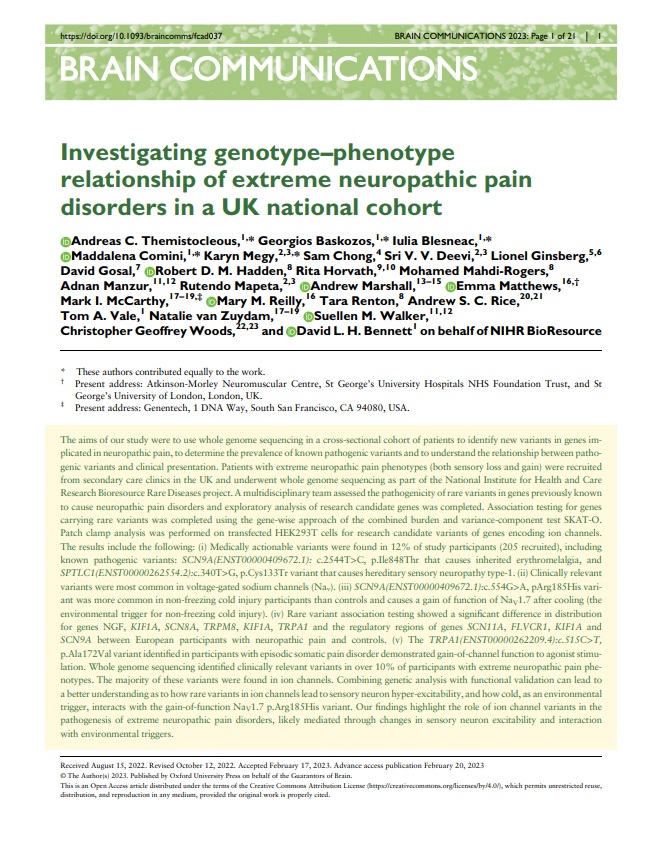Neuropathic Pain Disorders (access to 'Chromoscope' data platform)
Study code
DAA085
Lead researcher
Dr Andreas Themistocleous
Study type
Data only
Institution or company
University of Oxford (Nuffield department of Clinical Neuroscience)
Researcher type
Academic
Speciality area
Genomics and Rare Diseases, Dementias and Neurodegeneration, Neurological Disorders

Summary
The aims of our study were to use whole genome sequencing in a cross-sectional cohort of patients to identify new variants in genes implicated in neuropathic pain, to determine the prevalence of known pathogenic variants and to understand the relationship between pathogenic variants and clinical presentation.
Patients with extreme neuropathic pain phenotypes (both sensory loss and gain) were recruited from secondary care clinics in the UK and underwent whole genome sequencing as part of the National Institute for Health and Care Research BioResource Rare Diseases project. A multidisciplinary team assessed the pathogenicity of rare variants in genes previously known to cause neuropathic pain disorders and exploratory analysis of research candidate genes was completed.
Editors note:
The researchers behind this study are looking to further understand the genetic basis of this condition through accessing data on genotypes related to neuropathic pain disorders held on the University of Cambridge’s 'Chromoscope’* data platform.
* ‘Chromoscope’ is a data platform used by researchers wishing to analyse rare genetic variants. For the NIHR Bioresource Rare Disease Project, DNA from consenting participants was collected and their genetic information was stored for future research use. In order for this data to be anonymously accessed for research purposes the NIHR BioResource created an application called ‘Chromoscope’ (previously known as ‘Gene Docs’). ‘Chromoscope’ allows approved researchers to access this genetic data. Before access is given researchers must submit an application to the NIHR BioResource requesting access. The BioResource reviews these applications and if approved, researchers are given access to the required anonymised data.
Publication:
Themistocleous AC, Baskozos G, Blesneac I, Comini M, Megy K, Chong S, Deevi SVV, Ginsberg L, Gosal D, Hadden RDM, Horvath R, Mahdi-Rogers M, Manzur A, Mapeta R, Marshall A, Matthews E, McCarthy MI, Reilly MM, Renton T, Rice ASC, Vale TA, van Zuydam N, Walker SM, Woods CG, Bennett DLH (2022). 'Investigating genotype-phenotype relationship of extreme neuropathic pain disorders in a UK national cohort.' Brain Commun. 5(2).
Conclusions:
In our study, we identified clinically relevant variants in 12% of the participants, with an impact on clinical care and treatment. The majority of these variants are located in ion channels which are enriched in nociceptors and environmental triggers (such as cold in the case of non-freezing cold injury) may interact and enhance the gain-of-function impact of such variants.
